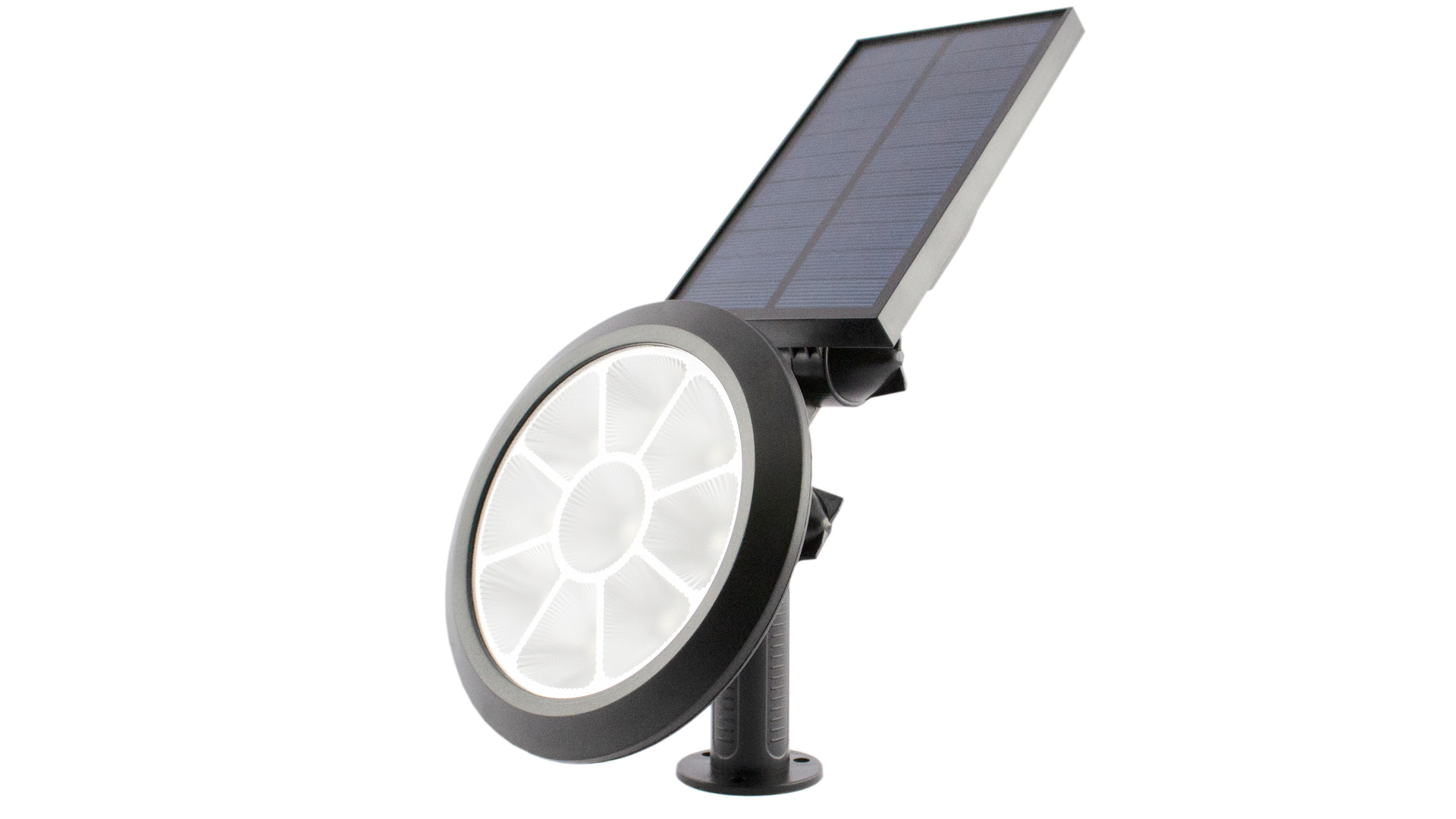

There are many reasons why the best outdoor solar lights are a zillion times better than the mains-powered alternative, at least when it comes to lighting up borders, shrubs and trees. The fact that you don’t need to get an electrician in to bury an armored cable around the lawn is one bonus – a massive bonus. That’s about £300 saved already.
Then there’s the old best lawn mower scenario. You know, the one where you run over connecting cables along the lawn edge and blow the house up because you ill advisedly failed to tuck the wires out of harm’s way. Or the many times you forgot to turn off the mains-powered, light-sensitive garden lights before going to bed so they burned all night long, increasing your electricity bill in the process. I could go on but I won’t.
The thing is, solar panel, LED and battery technology have come on in huge leaps and bounds over the last few years. Where earlier solar-powered lighting gave off a feeble glow that petered out after about four hours, today’s outdoor solar LED lights tend to run till well past bedtime and into the dead of night. They’re also properly bright, lighting up tall shrubs and even smaller trees. All you need is some direct sunshine for full effectiveness.
All outdoor solar lights are fitted with a battery (usually one of those lithium-ion types) and it’s this power source that kicks in at dusk when the light-sensitive sensor detects a general darkening of the area around it. All the solar panel does is feed the battery with sun juice during the day. Hence, placing the solar panel in direct sunlight is always the best course of action for long, bright light in the evening.
Today we’re comparing two sterling spiked solar models from the Solar Centre, an online store that arguably sells more solar-based products than anyone else. In the shrubbery section, we have the well-established two-lamp Atlas Solar Spotlights and lighting up the bush with no name, the new single-lamp Chiron Solar Spotlight with Seven Colour Options.
Both of these lamps excel at the task they were designed to do, but which product is best suited to your needs? Shall we find out?
Atlas Solar Spotlights vs Chiron Solar Colour Spotlight: design and features

Available in pairs or fours, the Atlas Solar Spotlights provide ample illumination for flowers, shrubs and smaller trees.
The Atlas comprises two spiked 4cm spot lights – with a flat wall fitting for mounting to decking, a fence or wall – and a separate spiked solar panel measuring 17cm x 19cm. Two sets of wires lead from the panel to each 50-lumen spot via a 4.5m splitter, so you can spread these lights out over a wide area of about 10 metres. A longer 5m cable is available separately from the Solar Centre for those who require even more reach. The spots themselves can be angled to highlight ground-level plants or pointed straight up under a tree. Their heavy duty casings are absolutely watertight and have remained so in this writer's garden even after tons of rain and freezing temperatures. Hence, the 12 month warranty has never been required.
Get all the latest news, reviews, deals and buying guides on gorgeous tech, home and active products from the T3 experts

The Chiron Solar Colour Spotlight adds a splash of colour to borders when the sun goes down.
The Chiron Solar Colour Spotlight is an entirely different type of solar lamp. Lamp being the operative word, because it comes in singles only. Unlike the Atlas model which has a separate solar panel that’s joined to the spots with a bunch of wires, the Chiron has its own small 14 x 9cm solar panel attached above the lamp, so it’s a much tidier, self-contained package. However, the Chiron’s large 12.5cm LED housing can’t be angled to as many degrees as the Atlas. In fact it’s impossible to have it pointing 90˚ upwards because the hinge on the solar panel gets in the way. It’s also not possible to adjust the sideways angle of the solar panel because it’s fixed in one direction. This could prove a problem for some users where the sun strikes the garden from an awkward angle.
The Chiron’s 12.5cm housing features a circle of eight bright LEDS plus an extra one in the centre. However, unlike the Atlas which provides just one colour (soft white), the Chiron has seven – red, blue, green, yellow, light blue, pink and cool white – and these can be set to transition from one colour to another or locked to a specific colour. Sadly, the colour transition mode is a bit clunky – instead of the lights subtly cross fading from one colour to another, they simply change abruptly every five seconds or so. I found it much more effective to have it set as a single colour and to do that requires crouching in the garden at night while they sequence through the colours. Once you’ve found the colour you like, simply press the rear rubberised button and it stays that hue every time the light switches on.
Atlas Solar Spotlights vs Chiron Solar Colour Spotlight: performance

Atlas Solar Spotlights
For such small units, the Atlas spots pack a lot of power – 100 lumens in total to be precise. They are easily bright enough to illuminate large shrubs, flowers and most medium-sized trees though the light effect does peter out after about 10 metres or so. I consider this a good thing because the last thing you want is your garden borders to look like a floodlit football stadium.
During the summer months of 2020, the Atlas switched on at about 9.30pm and stayed on well beyond midnight. Apparently they have a burn time of around 10 hours but I was well in the land of nod to ever really know. I’ve had the Atlas running since May 2020 and they have just kept on running, even in winter when there was hardly any sun on the garden, and without using the optional power save mode.
The Chiron is a new addition to this writer’s garden but it seems to be performing just as well as the Atlas. Actually, I have three installed at the moment and the effect is most pleasing. I gave up on the automatic colour changing option because they don’t transition nicely enough. Hence I now just use static colours. Green really accentuates the colour of bushes and shrubs, yellow adds a natural, warm tone and some users love using the red on their Acer Palmatums. The white light, though, is quite harsh though it does seem to illuminate a larger area.
So far, the Chirons have stayed on well past midnight and they emit more than enough light (I wasn’t able to find a lumen stat for this lamp but I’d say the white light setting’s brightness is about the same as the Atlas). I have one Chiron under a tall 70-foot silver birch and its soft yellow light is clearly illuminating the wonderful bark and lower branches up to about 30 feet with a softer glow visible for a further 10 feet or so. On an even darker night I’m sure half the tree would be clearly illuminated.
Atlas Solar Spotlights vs Chiron Solar Colour Spotlight: verdict

Chiron Solar Colour Spotlight
The verdict here depends on what type of setup you want. The Atlas – also available in fours – is an excellent choice if you want a cluster of lights to illuminate one side of the garden, while the Chiron has more colour options and can be placed pretty much anywhere. However, you only get one Chiron light for not much less than the price of two Atlas lights. Given that you may end up only using the Chiron’s white or yellow light options, it would seem that the Atlas set may be the better option, despite the extra wiring. Whichever model you decide, chances are you will have made a wise decision either way because both systems are really efficient and a doddle to setup.
- And these are the best outdoor lights
Derek (aka Delbert, Delvis, Delphinium, Delboy etc) specialises in home and outdoor wares, from coffee machines, white appliances and vacs to drones, garden gear and BBQs. He has been writing for more years than anyone can remember, starting at the legendary Time Out magazine – the original, London version – on a typewriter! He now writes for T3 between playing drums with his bandmates in Red Box (redboxmusic).
